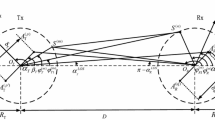Abstract
Geometrical models are mostly used for the study and analysis of the characteristics of radio communication channels. In this paper, a three-dimensional semi-ellipsoidal scattering model is proposed for mobile-to-mobile communication channels, where uniformly distributed scatterers are assumed to be confined within the semi-ellipsoids around mobile stations. The semi-ellipsoidal shape with adjustable dimensions is considered to model the scattering phenomenon in urban streets and canyons. Using the proposed scattering model, a closed-form expression for the joint probability density function of the Angle-of-Arrival in azimuth and elevation planes of the incoming multipath signals is derived at each mobile station. Moreover, various observations are made, which show the impact of scatterers’ elevation and streets’ orientation on the spatial characteristics of mobile-to-mobile communication channel.











Similar content being viewed by others
References
Akki, A., & Haber, F. (1986). A statistical model of mobile-to-mobile land communication channel. IEEE Transactions on Vehicular Technology, 35(1), 2–7. doi:10.1109/T-VT.1986.24062.
Baltzis, K. (2011). A generalized elliptical scattering model for the spatial characteristics of mobile channels. Wireless Personal Communications, 1–14.
Baltzis, K. (2011). A simplified geometric channel model for mobile-to-mobile communications. Radioengineering, 20(4), 961.
Batool, T., Matthias, P., et al. (2011). A geometrical three-ring-based model for MIMO mobile-to-mobile fading channels in cooperative networks. EURASIP Journal on Advances in Signal Processing. doi:10.1155/2011/892871.
Janaswamy, R. (2002). Angle of arrival statistics for a 3D spheroid model. IEEE Transactions on Vehicular Technology, 51(5), 1242–1247.
Kuchar, A., Rossi, J. P., & Bonek, E. (2000). Directional macro-cell channel characterization from urban measurements. IEEE Transactions on Antennas and Propagation, 48(2), 137–146. doi:10.1109/8.833062.
Nawaz, S. J., Khan, N. M., Patwary, M. N., & Moniri, M. (2011). Effect of directional antenna on the doppler spectrum in 3-D mobile radio propagation environment. IEEE Transactions on Vehicular Technology, 60(7), 2895–2903. doi:10.1109/TVT.2011.2161788.
Nawaz, S. J., Qureshi, B. H., & Khan, N. M. (2010). A generalized 3-D scattering model for a macrocell environment with a directional antenna at the BS. IEEE Transactions on Vehicular Technology, 59(7), 3193–3204. doi:10.1109/TVT.2010.2050015.
Patzold, M., Hogstad, B., & Youssef, N. (2008). Modeling, analysis, and simulation of MIMO mobile-to-mobile fading channels. IEEE Transactions on Wireless Communications, 7(2), 510–520.
Patzold, M., Hogstad, B., Youssef, N. & Kim, D. (2005). A MIMO mobile-to-mobile channel model: Part i- the reference model. In Proceedings of IEEE 16th international symposium on personal, indoor and mobile radio communications. (vol. 1, pp. 573–578) IEEE.
Paul, B., Bhattacharjee, R., et al. (2010). Time and angle of arrival statistics of mobile-to-mobile communication channel employing dual annular strip model. IETE Journal of Research, 56(6), 327.
Paul, B., Hasan, A., Madheshiya, H., Bhattacharjee, R., et al. (2009). Time and angle of arrival statistics of mobile-to-mobile communication channel employing circular scattering model. IETE Journal of Research, 55(6), 275.
Riaz, M. & Khan, N. M. (2011). Closed-form expressions for correlation function and power density spectrum in MIMO mobile-to-mobile channels using two-erose-ring model. In Proceedings of IEEE international conference on information and communication technologies (pp. 1–5). IEEE.
Samarasinghe, P., Lamahewa, T., Abhayapala, T. & Kennedy, R. (2010). 3D mobile-to-mobile wireless channel model. In Proceedings of Australian communications theory, workshop (pp. 30–34). doi:10.1109/AUSCTW.2010.5426757.
Vatalaro, F., & Forcella, A. (1997). Doppler spectrum in mobile-to-mobile communications in the presence of three-dimensional multipath scattering. IEEE Transactions on Vehicular Technology, 46(1), 213–219. doi:10.1109/25.554754.
Wang, L., Liu, W., & Cheng, Y. (2009). Statistical analysis of a mobile-to-mobile rician fading channel model. IEEE Transactions on Vehicular Technology, 58(1), 32–38.
Wei, C., Zhiyi, H. & Lili, Z. (2007). A reference model for MIMO mobile-to-mobile fading channel. In Proceedings of international conference on wireless communications, networking and mobile computing (pp. 228–231). IEEE.
Wu, T. & Kuo, C. (2007) 3d space-time-frequency correlation functions of mobile-to-mobile radio channels. In Proceedings of IEEE 65th vehicular technology conference (pp. 334–338). IEEE.
Zajic, A. & Stuber, G. (2006) Space-time correlated MIMO mobile-to-mobile channels. In Proceedings of IEEE 17th international symposium on personal, indoor and mobile radio communications (pp. 1–5). IEEE.
Zajic, A., & Stuber, G. (2008). Three-dimensional modeling, simulation, and capacity analysis of space-time correlated mobile-to-mobile channels. IEEE Transactions on Vehicular Technology, 57(4), 2042–2054. doi:10.1109/TVT.2007.912150.
Author information
Authors and Affiliations
Corresponding author
Rights and permissions
About this article
Cite this article
Riaz, M., Nawaz, S.J. & Khan, N.M. 3D Ellipsoidal Model for Mobile-to-Mobile Radio Propagation Environments. Wireless Pers Commun 72, 2465–2479 (2013). https://doi.org/10.1007/s11277-013-1158-0
Published:
Issue Date:
DOI: https://doi.org/10.1007/s11277-013-1158-0




